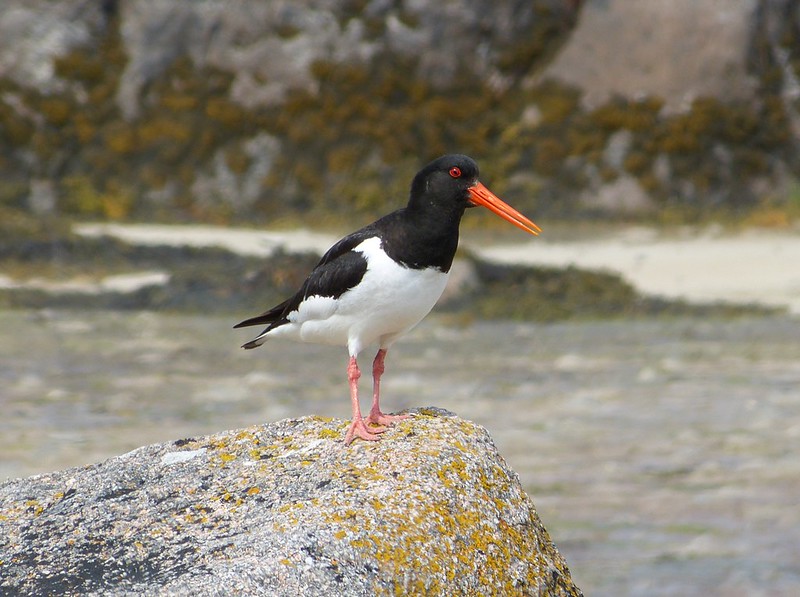
It’s perhaps appropriate that I should bring this series of Mull entries to a close with a post covering the area of natural history where my greatest interest lies. You’ve already seen the magnificent Golden Eagles with which we share our valley as well as rare breeders including Red Throated Diver and Golden Plover. That however is just the tip of a very large iceberg. Across two weeks we saw a remarkable 102 bird species including notable firsts such as a reeling Grasshopper Warbler and the previously detailed Red Grouse. Then of course there were the calling Corncrakes on Iona, a Short Eared Owl hunting at the end of our track, summer plumaged Great Northern Divers, male Hen Harriers, Greylag Geese flocking in their hundreds, Eiders on almost every beach, more Lesser Repolls than I’ve ever seen, recently fledged Sea Eagles, diving Gannets and even a leucistic Meadow Pipit. Given the season we also managed to confirm breeding not only for the aforementioned rarities but also for Oystercatcher, Redshank, Rock Pipit, Meadow Pipit, Black Guillemot, Shag, Pied Wagtail, Cuckoo, Greylag Goose, Eider, Chaffinch, Greenfinch, Great Tit, Blue Tit, Dunnock, Robin, House Sparrow, Blackbird, Starling, Common Gull, Arctic Tern and Common Tern to name but a few. There’s no way I could ever hope to cover everything on here so instead I shall focus on those species which managed to fall under my cameras spell, starting with the ubiquitous Wheatear. Everywhere we went they were a constant companion and with juveniles in abundance it was never too hard to find a poser.



Over on Iona the calling Corncrakes remained tantalisingly out of sight. At times we knew they couldn’t be further than a few meters from our position but the lush vegetation kept them safely hidden, a consequence of our late season visit. The island held other delights however including a very obliging adult and juvenile Song Thrush, the former smashing a snail shell open before feeding the contents to its offspring.


Rooks were our treat on Iona’s two main sandy beaches, a species that to my knowledge is not found anywhere else on Mull. One pair in particular took my attention as they defended a large and well developed chick, but sadly only the adults came into range.

Calgary beach is probably Mull’s most famous location due in no small part to its white sand and tropically clear and blue waters. Holiday makers flock there every summer, but so to it seems do Eider. Each year we’ve seen at least one family group take up residence and this time was no different with at least six adults and twenty chicks present. Unusually they were being incredibly tolerant of human disturbance and were even mingling amongst people paddling and swimming. That’s not something you get to see everyday.


As I mentioned above, Lesser Redpolls were very abundant this year for reasons unknown. Perhaps they’ve had a particularly good spring or maybe I’ve just got better at spotting them, but either way they were a delight to see. From Treshnish in the north to Fionnphort in the south we always seemed to be bumping into singles and at times even family groups of these colourful little birds.

Such an abundance of bird life also meant that we had a spectacular opportunity to brush up on our identification skills when it comes to Common and Arctic Terns. And when I say brush up I mean completely refresh as I’ve never been entirely happy with either. At Langamull beach a single pair of both species have managed to successfully raise at least one chick each with the adults now regularly patrolling the bay. Any perceived threat, no matter how distant, was met with a barrage of noise and skull threatening bombing runs, each one allowing up close views of what my guide reliably tells me are distinctive differences. After over an hour of intense observation I still don’t think I’m any clearer so hopefully this is an Arctic Tern as I believe.

I couldn’t do a bird post from Mull without including our mascot, Geoffrey. For the uninitiated Geoffrey is of course an Oystercatcher and boy was he making himself heard. Every inch of the coastline echoes to the sound of their calls and to be honest I’d not have it any other way.

Even now I’m barely scratching the surface so here’s a quick run-down through some other birding highlights.

Sand Martins

White-tailed Sea Eagle

Hooded Crow, Oban
With our must successful visit yet under our belts, thoughts naturally turn to what we can do to go one better next time. Ptarmigan have to be a natural target and are probably one of the trickiest birds to see on Mull due to their limited numbers and love of high altitude habitat. Then of course there are the occasional visitors such as Black Throated Diver and any number of passing sea birds, not to mention rare vagrants from the mainland such as Nuthatch, Magpie and Jay. Those latter three are likely to increase in number over the coming years so I suspect it wont be too long until we bag at least one, if not all. Time to start counting down the days until next time I think.




3 Comments
Carole M. · August 2, 2013 at 10:38 pm
..very lovely photographs you've shared here Adam, I loved the …trying to remember the name, sandpipers? Also the hooded crow, had never heard or seen that one before
Adam Tilt · August 6, 2013 at 6:52 pm
Thanks Carole. Here in the UK Hooded Crows are only found in the north of Scotland so it makes a nice change to see them when he head up that way.
Caroline Gill · August 24, 2013 at 6:40 pm
I have only just found these wonderful posts, Adam. We saw more Eiders this year than usual (on Skye and round Durness). And yes, lots of Hoodies!